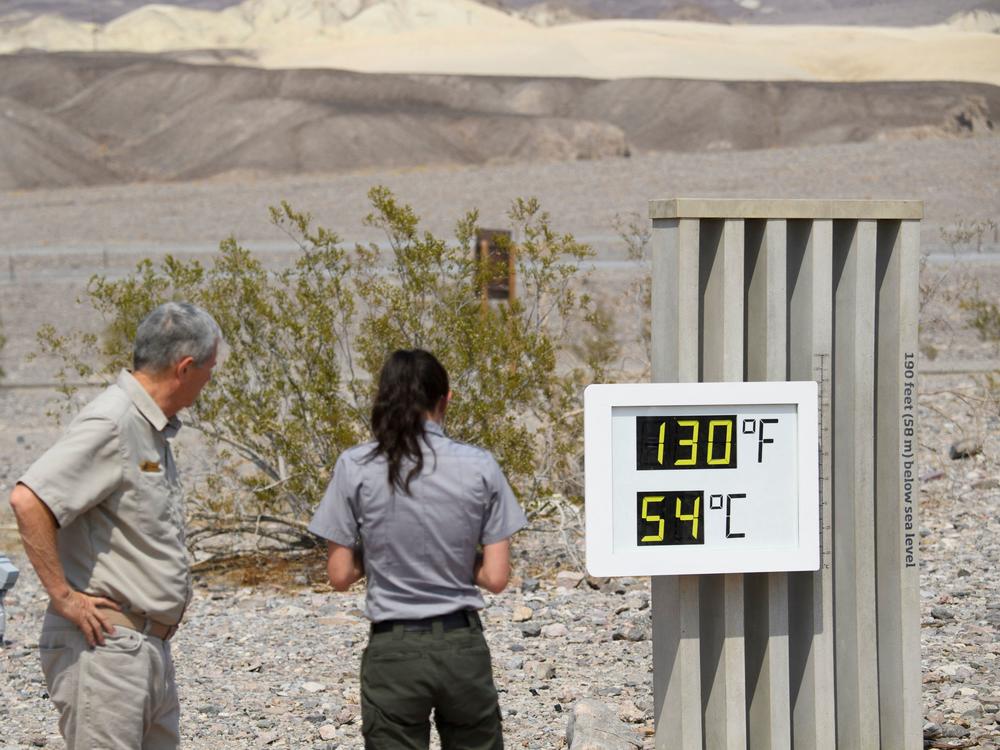Section Branding
Header Content
The Record Temperatures Enveloping The West Are Not Your Average Heat Wave
Primary Content
It might be tempting to shrug at the scorching weather across large swaths of the West. This just in: It gets hot in the summer.
But this record-setting heat wave's remarkable power, size and unusually early appearance is giving meteorologists and climate experts yet more cause for concern about the routinization of extreme weather in an era of climate change.
These sprawling, persistent high-pressure zones popularly called "heat domes" are relatively common in later summer months. This current system is different.
"It's not only unusual for June, but it is pretty extreme even in absolute terms," says Daniel Swain, climate scientist at the UCLA Institute of the Environment and Sustainability. "It would be a pretty extreme event for August," Swain says, when these typically occur.
From the Great Plains to the coast, cities are setting record temps
This heat dome's reach is remarkable, too: It has set record highs stretching from the Great Plains to coastal California. And these aren't just records for that specific date or month, but in a few spots, they are records for the singularly hottest day in the entire period of record, sometimes stretching back 100 to 150 years. "That's a pretty big deal," Swain says.
"It's unusual in that it's more intense in terms of the maximum temperature," says Alison Bridger, a professor in the Meteorology and Climate Science department at San Jose State University. "And how widespread the impact is."
For example, Palm Springs, Calif., recently hit 123 degrees, equaling its highest recorded temperature.
Las Vegas set a daily record of 114 degrees. Phoenix reached a record 118 degrees, the earliest the city has hit that high a mark. It broke the previous record of 114 set in 2015.
Sacramento, Calif., set a new daily record of 109 degrees. The National Weather Service just extended its excessive heat warning through Sunday night in the Central Valley and parts of northern California.
Denver this week hit 100 for three straight days, the earliest date of such a streak on record, tweeted meteorologist Bob Henson. He noted that all of the 100-degree streaks in Denver's 150 years of climate record keeping have occurred in the last three decades.
And in the Plains, several cities including Omaha, Neb., set records, including a daily record high of 105 degrees. That breaks an Omaha daily record set in 1918.
Just last year, several cities in the West also hit record highs.
This current heat dome "fits with climate change ideas, global warming, meaning that it's just a little bit warmer than it would have been last year," Bridger says. "And if we have this next year, it'll be just a little bit warmer again."
The "heat dome" is making droughts even worse
It's also coinciding with and worsening record drought across big parts of the West. These two things, Daniel Swain says, are now making each other worse.
"The drought is leading to extremely low soil moisture, which is making it easier for these high pressure systems to generate extreme heat waves because more of the sun's energy is going into heating the atmosphere rather than evaporating nonexistent water in the soil."
And that is only making things hotter and drier.
"That's sort of the vicious cycle of drought and extreme heat in a warming climate," he says.
It's more evidence of human-caused climate change
The excessive heat and widening drought continues to elevate wildfire risk across much of the West. New federal data show that the number of new wildfires in the U.S. so far this year is at a 10-year high, signaling a long, potentially dangerous summer and fall for wildfires.
Experts say this current heat dome is yet more evidence of the impact of human-caused climate change.
Bridger at San Jose State says while that is most likely the case, "it takes a lot of work to figure that out. A lot of hard scientific work in order to be statistically sure that it's associated with climate change," she says.
Others are more certain.
"It's just so clear at this point," says climate scientist Swain, "when it comes to record-breaking heat events, the study has been run for event after event after event in region after region after region in year after year."
And the answer is almost always the same, he says: "There's a crystal clear human fingerprint on extreme heat and extreme heat events ... climate change is making these sorts of things worse."
And what was historically rare is now becoming almost commonplace: Forecasters say there's a chance of yet another heat wave of similar magnitude in the West about 10 days from now.
"That sounds crazy, except that last summer we saw like three to five of these, you know, 'unprecedented events' in different regions of the West," Swain points out.
Copyright 2021 NPR. To see more, visit https://www.npr.org.

